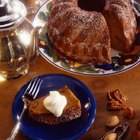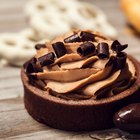
Many cake recipes and baking instructions focus on a particular baking pan size, such as two 8-inch round cake pans with a depth of 2 inches. While this works if you plan to make a layer cake or two small cakes, often you would rather make a large sheet cake, able to serve many more guests. Changing a pan size can alter the cake, leaving the inside underdone while the outside browns too quickly. With a few cooking changes, you can create a large cake with the same texture without having to alter your recipe.
Step 1
Prepare your baking pan as your recipe recommends, such as greasing or flouring. Pour your cake batter into the pan. A typical cake recipe for two 8-inch cakes makes 6 to 7 cups of batter, providing 3 to 3.5 cups for each cake and a batter thickness of about two inches. A typical 9-by-13 cake pan requires 7 cups of batter for the same thickness. Larger pans will result in thinner layers of batter or the need to double your cake recipe in order to maintain cake thickness.
Step 2
Measure the depth of the cake batter in your pan. If the batter level is less than the level in the 8-inch pans, heat is able to reach the center of the cake more rapidly, resulting in a cooking time of five to 10 minutes shorter. If the level of batter is thicker, heat takes longer to reach the center, resulting in increased cooking times by five to 20 minutes or more, depending on the size of your cake. If you increased the amount of batter used, such as 14 cups of batter instead of 7 cups, cooking time increases. For example, looking at round cakes, a typical 8-inch pan cooks for 30 to 35 minutes, while a 16-inch round pan cooks for 55 to 60 minutes, according to Baking911.com.
Step 3
Preheat your oven to the recommended temperature. If using a glass pan, reduce the temperature by 25 degrees Fahrenheit. If you are baking a large, thick cake, you may need to reduce the temperature by 25 degrees to reduce the risk of overbrowning before cooking is complete. Using the same example as in Step 2, an 8-inch pan cooks at 350 F, while a 16-inch pan cooks at 325 F.
Step 4
Set your kitchen timer for the cooking time you determined in Step 2, minus around 10 minutes. Check the cake for doneness by inserting a toothpick in the center. If the toothpick comes out clean, cooking is complete. If not, return the cake to the oven and recheck in a few minutes.
Related Articles

How Long to Bake Brownies Using Molds?
How Long Do You Bake a Double Batch of ...

For How Long Do You Bake a Cake in an 8 ...

How to Convert a Pan Cake to a Bundt ...

How to Cook Cheesecake in a Cupcake Pan
How to Measure Fondant
Easy White Cake Recipe

How to Make a Princess Doll Using the ...

Substitute for a Springform Pan

How to Make a Surfboard Cake
Easy Strawberry Cake Recipe

How to Steam Cook a Cake

How to Adjust the Oven Temperature for ...

How to Freeze Cakes Before Frosting

Number of Calories in Chocolate Mousse ...

How to Bake a Really Moist Boxed Cake

How to Thicken Cake Batter

How to Make a Cake Board

Calories in Fairy Cake

How to Store Leftover Pancake Batter
References
Tips
- Many baking supply stores or websites offer pan dimension charts that provide exact cooking times for different pan sizes, batter thickness and volume.
Warnings
- Adjusting temperatures and baking times does not always follow a hard and fast rule. When changing cake pan sizes, you may need to experiment with times and temperatures before you find what works best for your recipe.
Writer Bio
Deborah Lundin is a professional writer with more than 20 years of experience in the medical field and as a small business owner. She studied medical science and sociology at Northern Illinois University. Her passions and interests include fitness, health, healthy eating, children and pets.
Photo Credits
Jupiterimages/liquidlibrary/Getty Images